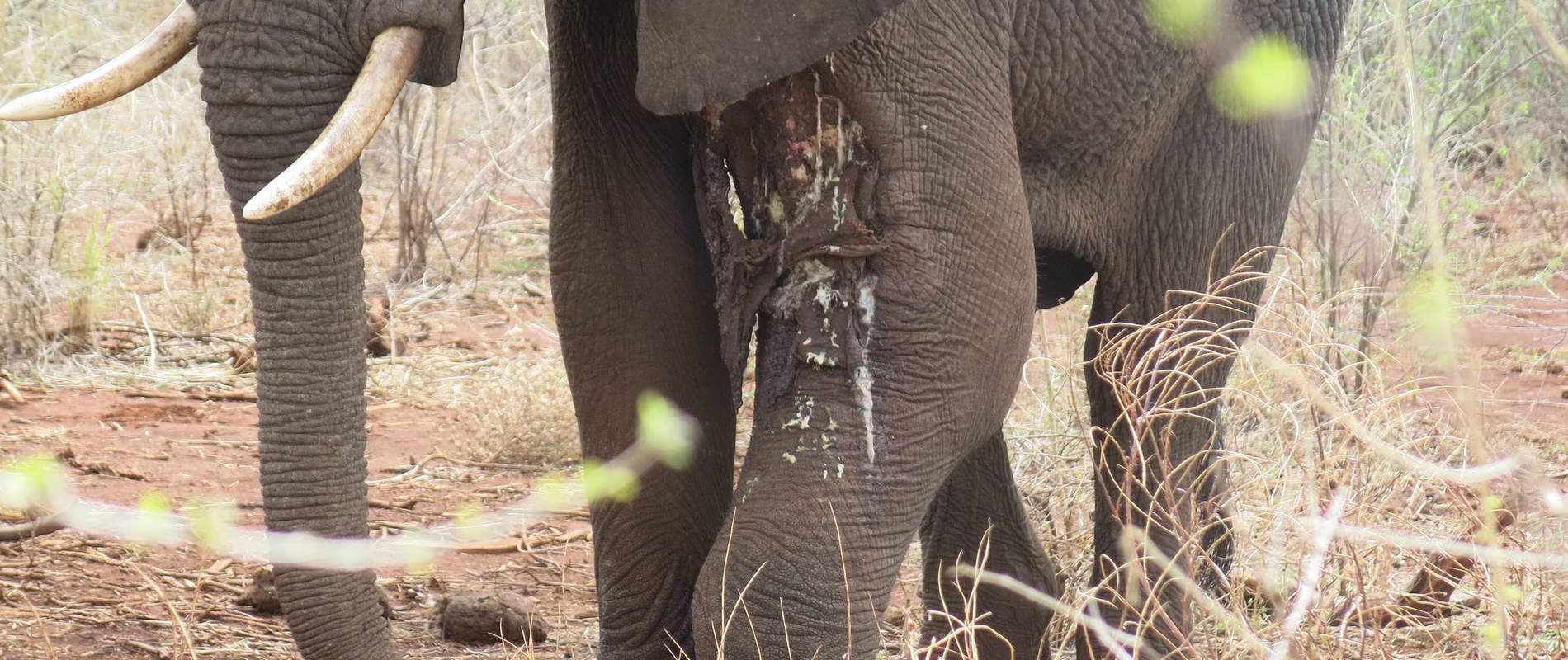FIELD VETERINARYREPORT FOR MERU FOR THE MONTH OF NOVEMBER 2016 Reported by: Bernard Rono Summary This report describes activities of the Meru veterinary unit in northern Kenya in November 2016
FIELD VETERINARYREPORT FOR MERU FOR THE MONTH OF NOVEMBER 2016
Reported by: Bernard Rono
Summary
This report describes activities of the Meru veterinary unit in northern Kenya in November 2016. Wildlife habitat in the Northern Area has rejuvenated following the beginning of the rainy season in November after a prolonged dry spell. This has relieved pressure from livestock on grazing and watering points and also incidences of Human Wildlife Conflict.
During this period the unit attended to the following cases:
CASE #1 LAMENESS IN A BULL ELEPHANT
Date: 12th November 2016
Species: Elephant
Sex: Male
Age: Adult
Location: Ol Jogi Conservancy
History
Scouts on patrol reported an elephant showing severe lameness at the boundary of Mpala and Ol Jogi Conservancies on 31st October 2016. A subsequent effort to track the elephant for treatment was unsuccessful until 12/11/2016 when it was reported by KWS rangers on patrol in Ol Jogi Conservancy. Following this report the elephant was immobilized for treatment.
Immobilization, examination and treatment
A helicopter was provided by the DSWT to dart this elephant. Captivon® 20mg was delivered in a 3cc Dan-Inject dart to the dorsal lumbar muscles and the anesthetic took effect within 5 minutes. The elephant was examined on left lateral recumbence after dousing the injury with plenty of water and covering its eyes with the ear flap.
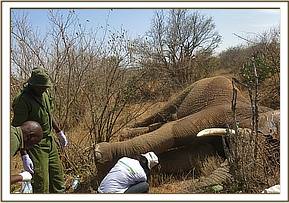

Examination showed a puncture wound approximately 1 centimeter in diameter penetrating into the carpal joint. On probing with a forceps the wound was more than 15 centimeters deep. These findings are consistent with gunshot injury although there was no exit point.
The wound was cleaned and the necrotic tissue removed with Hydrogen peroxide and application of topical antiseptic. The elephant was then administered with antibiotic and anti-inflammatory drugs.


Prognosis
Prognosis for this case is guarded due to the involvement of the joint. Our recommendation is that the elephant should be monitored closely to assess its response to treatment.
CASE #2: TRUNK INJURY TO A COW ELEPHANT
Date: 12th November 2016
Species: Elephant
Sex: Female
Age: Adult
Location: Ol Donyiro community land
History
Scouts from Samburu Trust reported an elephant with an injury and deformity of its trunk which prevented it from normal feeding or drinking. Closer observation of this elephant to determine the extent of injury was difficult because it was in a herd. KWS rangers in Ol Donyiro out post patrolled the area and located the elephant on the 12th November.
Immobilization, examination and treatment
Immobilization was achieved using Captivon® delivered in a 1.5cc Dan-Inject dart from a helicopter provided by DSWT. The dart was placed into the dorsal gluteal muscles after a brief chase into open ground. The first dart failed and a second dart was administered 20 minutes later which was effective and the elephant which fell into a ‘dog sitting’ posture and was tipped to left lateral recumbence for examination.
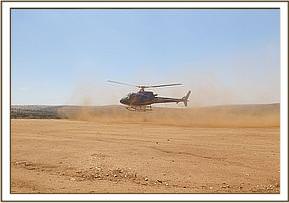

Examination showed a perforation on the mid ventral aspect of its trunk. This was an old wound which had healed with red scar tissue formation and deformity of the trunk. The cause of this traumatic injury could not be established.
No treatment was required. Antibiotics were administered to manage risk of infection due to immobilization stress.


Prognosis
We expect that this elephant will adapt to the deformity of its trunk.
CASE #3: LAMENESS IN A LIONESS
Date: 13th November 2016
Species: Lion
Sex: Female
Age: Adult
Location: Meru National Park
History
Field researchers in Meru National Park reported a lioness showing lameness on its right forelimb. It also had a malfunctioning collar which required replacement. The Vet Unit were called to immobilize this lioness to investigate the cause of lameness and replace the satellite collar.
Immobilization, examination and treatment
A combination of Ketamine and Medetomidine delivered in a Dan-Inject dart provided effective anesthesia. Full sedation was attained 9 minutes after darting. A blind fold was applied to prevent visual stimulation and the animal was positioned on lateral recumbence for examination and treatment.
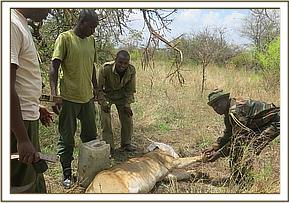

This lioness was in good body condition. A minor laceration was noted on the medial claw of the left forelimb which was treated by cleaning and application of Iodine antiseptic.


Examination of the right eye showed blindness caused by a collapsed eyeball suspected to have been caused by trauma. No eye discharge was seen. It was treated by application of topical antibiotic eye ointment.
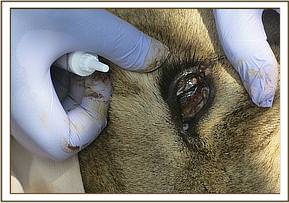

Prognosis
Good
CASE #4: POSTMORTEM OF ELEPHANT TREATED FOR SPEAR INJURY
Date: 13th November 2016
Species: Elephant
Sex: Male
Age: Sub adult
Location: Meru National Park
This elephant was initially examined and treated by the Meru Vet Unit on 29th October for spear inflicted injuries to its left shoulder muscle. Follow up treatment was done by Dr. Njoroge on 4th November 2016. An assessment on 13th November showed extensive necrosis of the skin and soft tissue around the left scapula and neck. Although its body condition had deteriorated, this animal could move to the watering point and browse. We were hopeful that this elephant would recover from the debilitating injury.
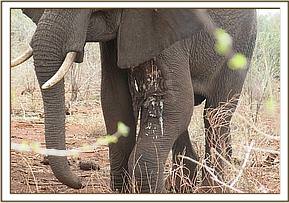

On 21st November, this elephant succumbed to injuries from the suspected poison laced spear. Its tusks were retrieved for preservation at the KWS armoury.
CASE #5 SNARE REMOVAL FROM A ZEBRA
Date: 23rd November 2016
Species: Common zebra
Sex: Female
Age: Adult
Location: Aberdare Country Club
History
A common zebra in the Aberdare Country Club suffered severe lameness caused by a wire snare around its right front leg. The snare had cut through the soft tissue of the fetlock joint. KWS senior warden in the Aberdares National Park requested for immediate attention to remove this snare.
Immobilization, examination and management
Immobilization was achieved by darting from a vehicle using a combination of Captivon® and Azaperone delivered in a Dan-Inject dart into the gluteal muscles. After 4 minutes the zebra fell onto sternal recumbency and was tipped to left lateral recumbence and a blindfold applied for examination.
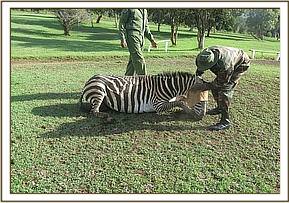
Examination revealed that the wire snare caused fetlock joint disarticulation and infection, coronary band necrosis and loss of the hoof.
Considering the debilitating injury caused by the snare, we recommended euthanasia to relieve pain and suffering of this zebra.


A debilitating snare injury in a common zebra in Aberdare Country Club
Acknowledgements
We thank the David Sheldrick Wildlife Trust for providing a helicopter for elephant immobilization and funding. Samburu Trust and other conservancies and KWS staff in the field provided support in locating, reporting and monitoring injured animals.
